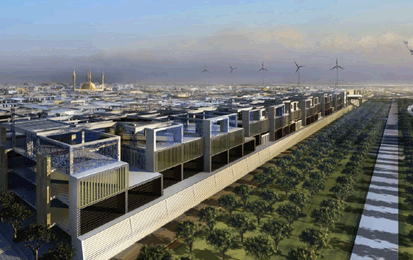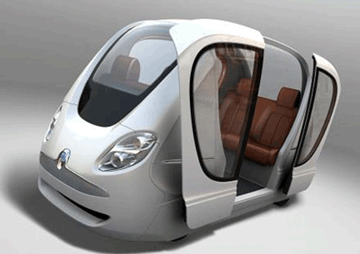
Take a look at the picture above. This is the recently operationalized city of Masdar, one that seems to come right off the drawing boards of 2001: A Space Odyssey or at least Star Wars. Imagine a city with zero carbon emissions. Imagine a perfectly planned city from top to bottom, fueled by solar power and clean as the pure desert sand. This one happens to have been built on the desert sand, only a short commute by a carbon-emitting vehicle from the city of Abu Dhabi. Forget the Seven Wonders of the Ancient World; here is Futurama out of the Arabian Nights.
Today’s New York Times has a lengthy article about the architectural feat, designed by Foster & Partners. All it takes is money (lots of money) and visionary architects. In this Disney on Sand there are even battery-powered pod vehicles, which operate underground out of sight and take people from place to place without drivers. The author of the article, Nicolai Ouroussouf, mixes praise with a dose of populist realism and rightly so:
Norman Foster, the firm’s principal partner, has blended high-tech design and ancient construction practices into an intriguing model for a sustainable community, in a country whose oil money allows it to build almost anything, even as pressure grows to prepare for the day the wells run dry. And he has worked in an alluring social vision, in which local tradition and the drive toward modernization are no longer in conflict — a vision that, at first glance, seems to brim with hope.
But his design also reflects the gated-community mentality that has been spreading like a cancer around the globe for decades. Its utopian purity, and its isolation from the life of the real city next door, are grounded in the belief — accepted by most people today, it seems — that the only way to create a truly harmonious community, green or otherwise, is to cut it off from the world at large.

Masdar is a millionaire’s experiment in Utopia, obviously for only a very small number of people and sustainable only at the outlay of enormous expense for not truly tested technology. But like the great Gothic cathedral architects of Europe, the result is one that perpetuates social class. Since the first cities developed, there has always been a spectrum of occupants, from the very rich to the very poor. Masdar has no room for the poor; no opportunities for the unskilled apart from the servant roles that rich people pay for. There is room for shopping malls with the latest Gucci handbags and a pristine view of a constructed Islamic community, the ultimate gated community where wealth rather than piety is the welcoming mat.
If there are more cities like this in the future, and perhaps there will be, will they become the castle keeps of the mega-rich? Certainly a poor country like Yemen or Haiti will not be following suit when it is difficult to help their citizens even have a roof over their head. I certainly applaud any nation which invests in futuristic architecture rather than weapons. But why build a city from scratch in the desert for a privileged few when so many barely have the means to make it through the day? Are the starving Muslim children in Sudan less important than science-fiction pod cars and massive shopping malls (both of which strengthen Western companies)? Need one be an ardent socialist or a Mother Teresa to note that we humans, Muslim and non-Muslim, spend far more time building and using weapons that take life than helping others to have even a chance with life. I am wondering which of the respected Prophets of old would move to Masdar, and which would be volunteering to comfort the homeless.
Daniel Martin Varisco